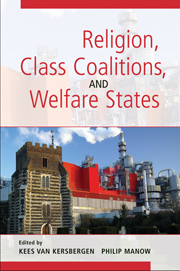Book contents
- Frontmatter
- Contents
- Preface
- List of Contributors
- 1 Religion and the Western Welfare State – The Theoretical Context
- 2 Western European Party Systems and the Religious Cleavage
- 3 The Religious Foundations of Work-Family Policies in Western Europe
- 4 Italy: A Christian Democratic or Clientelist Welfare State?
- 5 Religion and the Welfare State in the Netherlands
- 6 A Conservative Welfare State Regime without Christian Democracy? The French État-Providence, 1880–1960
- 7 Religion and the Consolidation of the Swiss Welfare State, 1848–1945
- 8 The Church as Nation? The Role of Religion in the Development of the Swedish Welfare State
- 9 The Religious Factor in U.S. Welfare State Politics
- 10 Religious Doctrines and Poor Relief: A Different Causal Pathway
- Index
9 - The Religious Factor in U.S. Welfare State Politics
Published online by Cambridge University Press: 28 January 2010
- Frontmatter
- Contents
- Preface
- List of Contributors
- 1 Religion and the Western Welfare State – The Theoretical Context
- 2 Western European Party Systems and the Religious Cleavage
- 3 The Religious Foundations of Work-Family Policies in Western Europe
- 4 Italy: A Christian Democratic or Clientelist Welfare State?
- 5 Religion and the Welfare State in the Netherlands
- 6 A Conservative Welfare State Regime without Christian Democracy? The French État-Providence, 1880–1960
- 7 Religion and the Consolidation of the Swiss Welfare State, 1848–1945
- 8 The Church as Nation? The Role of Religion in the Development of the Swedish Welfare State
- 9 The Religious Factor in U.S. Welfare State Politics
- 10 Religious Doctrines and Poor Relief: A Different Causal Pathway
- Index
Summary
In the political class theories discussed by Manow and van Kersbergen in the first chapter in this volume, the welfare state was depicted as a project of the Left and more specifically of Social Democrats and trade unions. Although proponents of this strong class power thesis acknowledged that Catholicism was a factor in shaping the institutional features of welfare states in Christian Democratic nations, they otherwise neglected the effects of religious doctrine, anticlericalism, Protestantism, and church–state conflict on welfare state development. Political class theories fail to consider how these forces have influenced decisions regarding such contentious issues as whether the state or society should be responsible for the protection of mothers and children and the socialization of children.
The United States never fit the narrative of class politics envisioned by power resource theory and departs in key features from the historical trajectory of continental Europe and the Scandinavian countries discussed in the other chapters. Whereas the labor movement in Europe emerged out of the struggle for the franchise, in the United States, voting rights were nearly universal by the 1880s (at least for adult white males). Furthermore, the European labor movement regarded the modern state as the source of autonomy, whereas the labor movement in the United States viewed the state as an instrument of coercion for breaking strikes and halting the advance of unionization (Sombart 1906 [1976]). Suspicion of state power made the American trade unions wary of government welfare programs and in favor of union-controlled benefits, which they negotiated through collective bargaining contracts (Quadagno 1988; Stevens 1988).
- Type
- Chapter
- Information
- Religion, Class Coalitions, and Welfare States , pp. 236 - 266Publisher: Cambridge University PressPrint publication year: 2009
- 3
- Cited by



